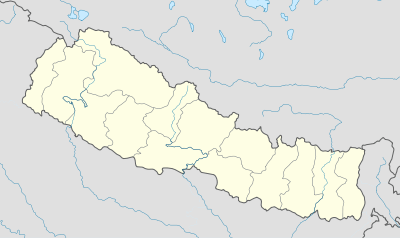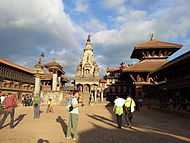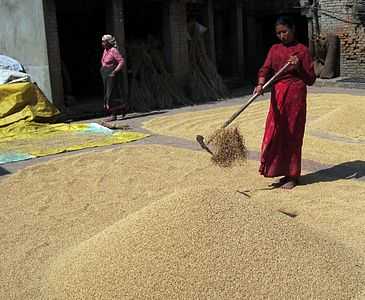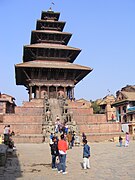Bhaktapur
| Bhaktapur भक्तपुर Khwopa | |
|---|---|
| Town | |
|
Bhaktapur Durbar Square | |
 Bhaktapur Location in Nepal | |
| Coordinates: 27°40′20″N 85°25′40″E / 27.67222°N 85.42778°ECoordinates: 27°40′20″N 85°25′40″E / 27.67222°N 85.42778°E | |
| Country | Nepal |
| Zone | Bagmati Zone |
| District | Bhaktapur District |
| Population (2011) | |
| • Total | 81,748 |
| • Religions | Hindu, Buddhism |
| Time zone | Nepal Time (UTC+5:45) |
| Postal code | 44800 |
| Area code(s) | 01 |
| Wikimedia Commons has media related to Bhaktapur. |
Bhaktapur (Nepali: भक्तपुर Bhaktapur ), literally translates to Place of devotees. It is redeemed as the 'cultural gem'. Also known as Bhadgaon or Khwopa (Nepal Bhasa: ख्वप Khwopa), it is an ancient Newar city in the east corner of the Kathmandu Valley, Nepal, about eight miles from the capital city, Kathmandu. It is located in Bhaktapur District in the Bagmati Zone.
Bhaktapur was the largest of the three Newa kingdoms of the Kathmandu Valley, and was the capital of Nepal during the great "Malla "Kingdom until the second half of the 15th century. Today it is the third largest city in the Kathmandu Valley, with a population of more than 80,000, of which the vast majority are still Newars. Historically more isolated than the other two kingdoms, Kathmandu and Patan, Bhaktapur has a distinctly different form of the Nepal Bhasa .
Bhaktapur has the best preserved palace courtyards and old city center in Nepal, and is listed as a World Heritage Site by UNESCO for its rich culture, temples, and wood, metal and stone artworks. This is supported by the restoration and preservation efforts of German-funded Bhaktapur Development Project (BDP).
The city is famous for special type of curd called "Ju Ju(king) dhau(curd). It is experienced by the curd makers that the taste of curd prepared in this location cannot be found elsewhere all over Nepal.
Etymology
KHWOPA is the ancient name of Bhaktapur. The term "Bhaktapur" (Sanskrit/Nepali: भक्तपुर) refers to "The City Of Devotees". This Bhaktapur City is also known as "Khwopa" (Nepal Bhasa: ख्वप) or "Bhadgaon" (Nepali:भादगाँउ) or "Ancient Newari Town" throughout the Kathmandu Valley. "Kh0apa" actually refers to the masks which are believed to have been worn by gods and goddesses. Bhaktapur is popular for different forms of mask dances based on lives of different deities and therefore, it was named "Khwapa" which later came to become just "Khwopa," which is also near to meaning masks.
History
It is the home of traditional art and architecture, historical monuments and craft works, magnificent windows, pottery and weaving industries, excellent temples, beautiful ponds, rich local customs, culture, religion, festivals, musical mystic and so on. Bhaktapur is still an untouched as well as preserved ancient city that is itself a world to explore for tourists.
From time immemorial it lay on the trade route between Tibet and India. This position on the main caravan route made the town rich and prosperous.
Demographics
At the time of the 2001 Nepal census it had a population of 72,543.[1] The male inhabitants of this city wear a special type of cap called the Bhadgaunle Topi.
Landmarks

Layaku (Durbar Square)
Bhaktapur Durbar Square is a conglomeration of pagoda and shikhara-style temples, mostly dedicated to Hindu gods and goddesses grouped around a 55-window palace of brick and wood. The square is one of the most charming architectural showpieces of the valley as it highlights the ancient arts of Nepal. The golden effigies of the kings perched on the top of stone monoliths, the guardian deities looking out from their sanctuaries, the wood carvings in every place — struts, lintels, uprights, tympanums, gateways and windows — all seem to form a well-orchestrated symphony.[2] The main items of interest in the Durbar Square are:
- The Lion Gate: Dating as far back as 1696 AD, this gate is guarded on either side by two huge statues of lions. Alongside there are two stone images of Bhairab (the dreadful aspect of Shiva) and ugrachandi (the consort of Shiva in her fearful manifestation).[2]
- Lu Dhowka (The Golden Gate) is said to be the most beautiful and richly moulded specimen of its kind in the entire world. The door is surmounted by a figure of the Hindu goddess Kali and Garuda (mythical griffin) and attended by two heavenly nymphs. It is embellished with monsters and other Hindu mythical creatures of marvellous intricacy. Percy Brown, an eminent English art critic and historian, described the Golden Gate as "the most lovely piece of art in the whole Kingdom; it is placed like a jewel, flashing innumerable facets in the handsome setting of its surroundings." The gate was erected by King Ranjit Malla and is the entrance to the main courtyard of the palace of fifty-five windows.[2]
- The Palace of Fifty-five Windows was built during the reign of King Yaksha Malla in 1427 AD and was remodeled by King Bhupatindra Malla in the 17th century. Among the brick walls, with their gracious setting and sculptural design, is a balcony of fifty-five windows, considered to be a unique masterpiece of woodcarving.[2]
- The Picture Gallery is of considerable value which contains ancient paintings belonging to the Hindu and Buddhist Tantrism of various periods and descriptions. This gallery is closed Tuesday.[2]
- The Statue of King Bhupatindra Malla in the act of worship can be seen on a column facing the palace. Of the square's many statues, this is considered to be the most magnificent.[2]
- Batsala Temple: The stone temple of goddess Batsala Devi includes many intricate carvings; however, it is most famous for its bronze bell, known to local residents as "the bell-of barking dogs," as when it is rung, dogs in the vicinity bark and howl. The colossal bell was hung by King Ranjit Malla in 1737 AD and was used to sound the daily curfew. It is now rung every morning when goddess Taleju is worshiped.[2]
- The Pashupati Temple is a replica of the famous temple by the Bagmati river in Kathmandu and is widely noted for the erotic carvings on its struts. It was built by King Yakshya Malla.[2]
The royal palace was originally situated at Dattaraya square and was only later moved to the Durbar square location. The square in Bhaktapur was severely damaged by an earthquake in 1934 and hence appears more spacious than the ones at Kathmandu and Patan.
Nyatapola Temple

This five-storeyed pagoda-style tantric temple was built by King Bhupatindra Malla in 1702 AD. It stands on five terraces, on each of which squat a pair of figures: two famous wrestlers, two elephants, two lions, two griffins, and Baghini and Singhini — the tiger and the lion goddesses. Each pair of figures is considered ten times stronger than the ones immediately below, while the lowest pair, the two Rajputs Jaya Malla and Phatta, were reputedly ten times stronger than any other men. This is one of the tallest pagoda-style temples in Kathmandu Valley and is famous for its massive structure and subtle workmanship.[2]
Bhairab Nath Temple

This is another pagoda temple of lord Bhairab, the dreadful aspect of Lord Shiva. It stands a short distance away from the temple of Nyatapola and was originally constructed by King Jagat Jyoti Malla on a modest scale. It was later remodelled by King Bhupatindra Malla, a zealous lover of the arts, into what it is now a three-storeyed temple.[2]
Dattatraya Temple
The temple of Dattatraya is as old as the Palace of Fifty-five Windows. Consecrated by King Yakshya Malla in 1427 AD, this temple, according to popular belief, was built out of the trunk of a single tree. It was subsequently repaired and renovated by King Vishwa Malla in 1458 AD.[2]
Just beside temple is a monastery (Math) with exquisitely carved peacock windows. These famous windows were carved during the reign of King Vishwa Malla. The monastery is full of artistic facades of latticed windows and engraved columns.[2] holi
Changu Narayan
Changu Narayan is an ancient Hindu temple located near the village of Changunarayan in the Kathmandu Valley on top of a hill at the eastern end of the valley. It is 6 kilometres (3.7 mi) to the north of Bhakathapur and 22 kilometres (14 mi) from Kathmandu. The temple is one of the oldest Hindu temples of the valley, and is believed to have been constructed first in the 4th century. Changu Narayan is the name of Vishnu, and the temple is dedicated to him. A stone slab discovered in the vicinity of the temple dates to the 5th century, and is the oldest such stone inscription discovered in Nepal. It was rebuilt after the old temple was devastated. Many stone sculptures here date to the Licchavi period. Changu Narayan Temple is listed by UNESCO as a World Heritage Site.[3][4]
The temple is a double-roofed structure where the idol of Lord Vishnu in his incarnation as Narayana is deified. The exquisitely built temple has intricate roof struts showing multi-armed Tantric deities. A kneeling image of Garuda (dated to the 5th century), the vahana or vehicle of Vishnu with a snake around its neck, faces the temple. The gilded door depicts stone lions guarding the temple. Gilded windows also flank the door. A conch and a disc, symbols of Vishnu, are carved on the two pillars at the entrance. Non-Hindus are not allowed inside the temple.[4]
Ta Pukhu (Siddha Pokhari)
Ta Pukhu (Siddha Pokhari) is a big rectangular water pond near the main city gate. It was built during the reign of King Yakshya Malla in the early 15th century and is associated with a number of myths. From this spot a wide range of snowy peaks are visible on clear days.[2]
Kailashnath Mahadev Statue
Kailashnath Mahadev is the World's Tallest Lord Shiva statue. The height of this statue is 143 feet high and is situated 20 km from Kathmandu, Nepal.The statues construction work was started in 2004 and was completed in 2012.The statue's inauguration took place on the 21st of June'12. This statue has attracted tourism into Nepal due to it being the tallest and as Lord Shiva is recognized as the lord of the gods in Hindu religion, there are many followers. Mr.Kamal Jain is the man behind this statue and behind the vision of this statue in Nepal. He is the person who had a dream to see the tallest lord shiva statue in Nepal and therefore he worked hard and pulled all the resources to make this happen. It was commissioned by Mr.Kamal Jain, and he has continued to develop and maintain the site without any support of the government of Nepal. This statue stands on the 32nd position in the list of all statues by height in the whole world. It has been made of copper, cement, zinc, and steel. To make this gigantic structure possible there were many professional workers and statue makers from India.
Festivals
Bhaktapur is also known as city of festivals and celebrations. The city celebrates festivals each month starting from new year to the Holi puni at the end of the year.
- Bisket jatra (New year festival)
This ancient annual festival of bhaktapur takes place at the New Year of the Bikram Sambat calendar. A few days before the New Year, usually at Chaitra 27 or Chaitra 28, if 31 days in month..,the goddess 'bhadrakali' and the god 'bhairab' are enshrined in their raths, or immense chariots,& pulled through the narrow streets of Bhaktapur by crowds of young men. The chariots rest at certain time-honored places in the city and people come out to throw offerings of flower, rice, coins and red sindur powder. On the last day of the old year a towering wooden pole known as ' lyesing dha: or lingo 'is erected at the edge of town. Long banners hang from the pole, symbolizing snakes..Nag and nagini.On new year's day, the erected pole is brought down symbolizing victory over evil !..People enjoy New year day along with victory over evils .On baisakh 5 ,the chariot is again pulled to narrow street of bhaktapur and brought to its origin place ,Taumadhi square marking end of Bisket Jatra.
- Mother's Day (Mathathirtha Aunshi)
- Buddha purnima (Buddha purnima)
- Kumar Khasti (Sithi Nakha)
- Gathamaga charya
- Sa: Paaru (Gai Jatra)
- Father's day (Kushe Aushi)
- Pulu Kisi (Indra Jatra)
- Dashain (Nawaratri)
- Tihar (Kija puja, Mha puja)
- Sakima punhi
- Dhanya purnima (Yomari purnima)
- Maghe sankranti (Ghya-chaku sankranti) (Makar Sankranti)
- Shree panchami
- Shiva ratri
- Holi (Holi purnima)
- Karkat sakranti (celebrated on Shrawan 1 of Nepali Calendar)
In popular culture
Portions of the movie Little Buddha starring Keanu Reeves and Bridget Fonda were filmed in the Bhaktapur Durbar Square.
See also
Gallery
-

Bhaktapur Durbar Square
-

Bhaktapur Taumadhi square.
-

Statue of King Bhupatindra Malla at Bhaktapur Durbar Square
-
View of Taumadhi square
-
Peacock Wimple.jpg|Taumadhi square as seen atop the Nyatapola Temple, Bhaktapur
-
Temple of Nyatapola
-

Statue of a wrestler at Nyatapola temple
-

Woman drying rice
-
Nepali curd
-
Bhaktapur Durbar Square
Footnotes
References
- Bindloss, Joe; Holden, Trent; Mayhew, Bradley. (2009). Nepal. Lonely Planet.
- Destination Nepal: Bhaktapur, Retrieved: 9 Dec, 2011
External links
| Wikimedia Commons has media related to Bhaktapur. |
 Bhaktapur travel guide from Wikivoyage
Bhaktapur travel guide from Wikivoyage- Old pictures of Bhaktapur from 1920
- Explore Nepal: Bhaktapur
- Bhaktapur, Calm in Chaos
- A Morning in Bhaktapur
| ||||||||||||||||






